VDB function - Calculate asset depreciation by the declining balance method in Excel
The following article details the meaning and usage of the VDB function - Calculating depreciation of fixed assets in excel.
Description: The function calculates the depreciation for an asset for multiple specified periods, the calculation function is based on the double-declining balance method.
Syntax : VDB (cost, salvage, life, start_period, end_period, [factor], [no_switch]) .
Inside:
- cost : The initial cost of the property, is a fixed parameter.
- salvage : The recovery value of an asset is the value after depreciation of the asset, a required parameter.
- life : Number of depreciation periods of the asset, which is a required parameter.
- start_period : The first period to calculate the depreciation of assets, is a required parameter.
- end_period : The last period you want to calculate depreciation, which is a required parameter.
- factor : The descending ratio of the balance, is an optional parameter, if omitted, the default is 2.
- no_switch : The logical value used to determine if the depreciation amount greater than the reduction of the balance will switch to the straight-line depreciation method.
+ Case no_switch = True : Do not switch to the straight-line method of depreciation even if the value of depreciation is larger than the declining balance.
+ Where no_switch = False or omitted : Carrying over to the depreciation method according to the straight line when the depreciation value is larger than the declining balance.
Attention:
- In case you do not want to use the double-declining balance method when calculating depreciation -> change the Factor value .
- All parameters (other than no_switch ) must be positive.
For example:
Calculate the depreciation of assets for each period of time when the purchased assets are valued at VND 65,000,000, the recovered value at the expiry is VND 20,000,000, the expiry date is 10 years and used in many periods.
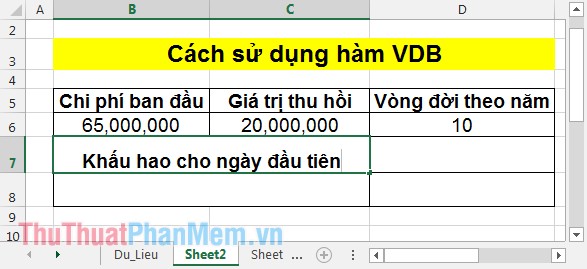
1. Depreciation on the first day
- Due to daily depreciation, life cycle value in day units => enter the formula: = VDB (B6, C6, D6 * 365,0,1) .
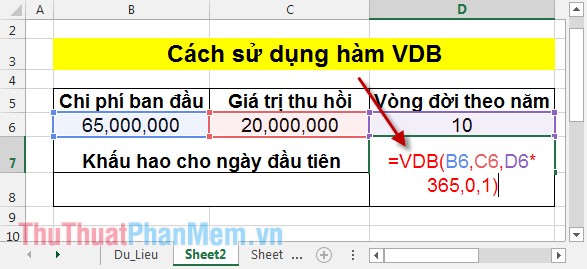
Press Enter -> the value of depreciation in the first day is:
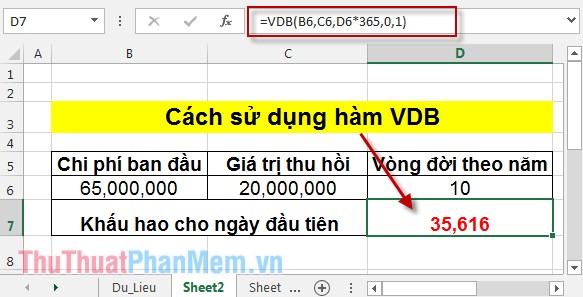
2. Depreciation in the first month
- Because of the monthly depreciation, the life cycle must be calculated by month -> enter the formula: = VDB (B6, C6, D6 * 12,0,1) .
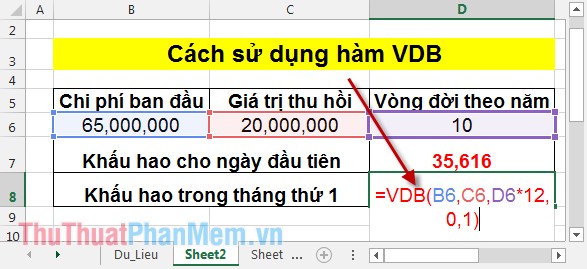
Press Enter -> the depreciation value in the first month is:
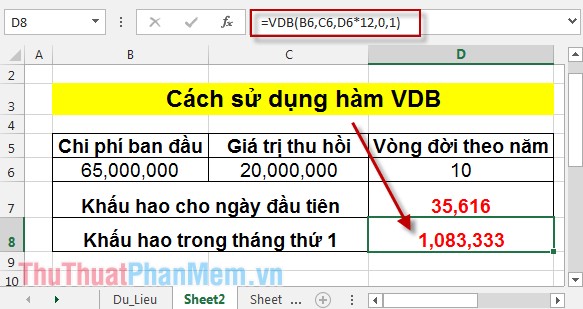
3. Depreciation in the first year
In the cell to calculate enter the formula: = VDB (B6, C6, D6,0,1) .
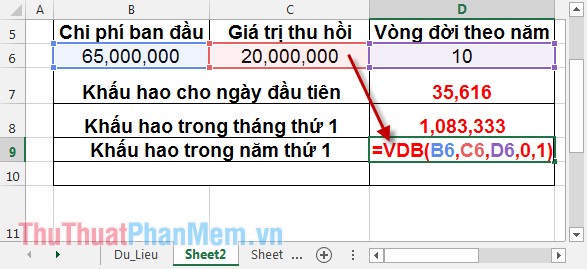
Press Enter -> the depreciation value in the first year is:
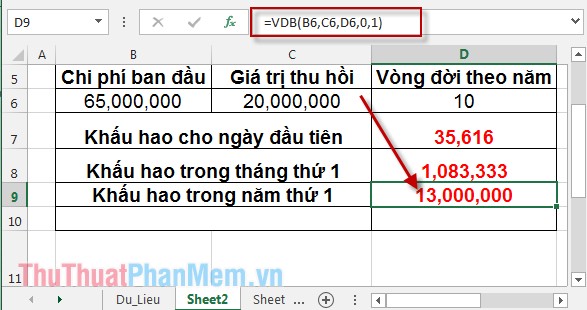
4. Depreciation for the sixth month to the 8th month using the double declining balance method
Because of the depreciation between months, the life cycle is calculated by month -> in the cell to be calculated, enter the formula: = VDB (B6, C6, D6 * 12,6,24) .
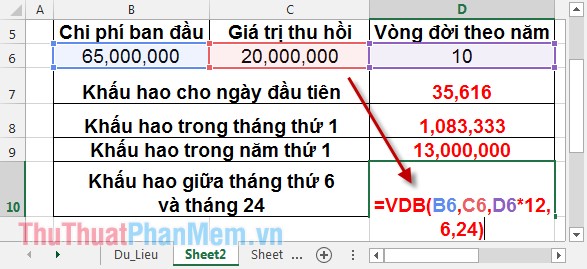
Press Enter -> the depreciation value from June to May 24 is:
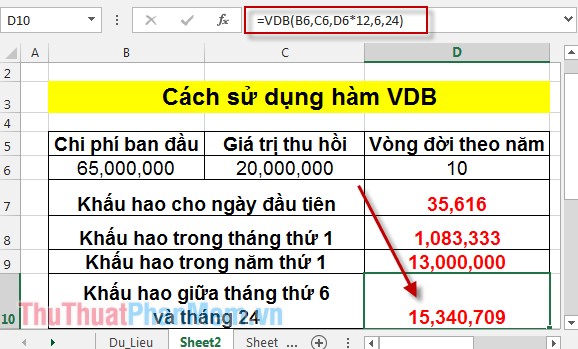
5. Depreciation 6 months to 24 months using the straight-line method with factory = 1.8
Similarly the above in the cell to enter the formula: = VDB (B6, C6, D6 * 12,6,24,1.8) .
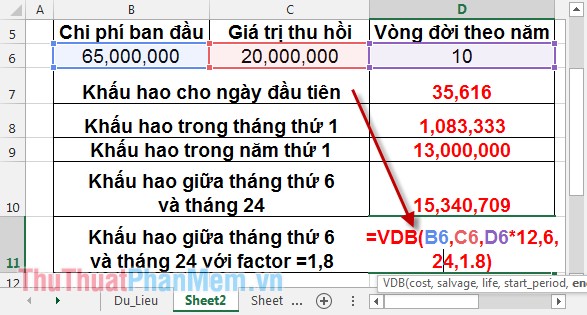
Press Enter -> the value of depreciation from June to May 24 using the straight-line method with factor = 1.8 is:
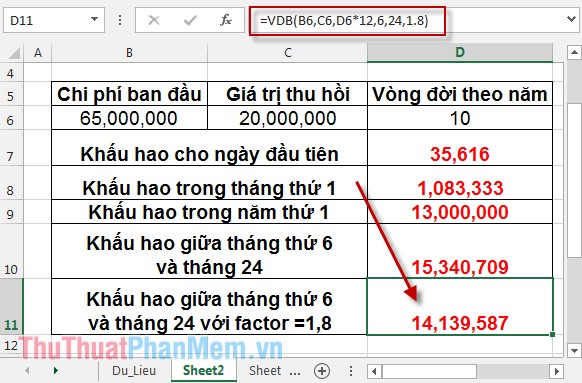
Thus, the two straight-line method and the double-decreasing balance have completely different results.
The above is the meaning and cases of calculations in the VDB function hope to help you.
Good luck!
You should read it
- SLN function - Returns the depreciation value of an asset using the straight-line method in Excel
- DB function - The function calculates the depreciation of assets with specific maturity in Excel
- How to use the SUM function to calculate totals in Excel
- AMORDEGRC function - The function returns the depreciation for each accounting period in Excel
- How to use the kernel function (PRODUCT function) in Excel
- SUM function in Excel: How to use SUM to calculate totals in Excel - SUM function in Excel
- How to use the Power function in Excel
- How to use DSUM function in Excel
May be interested
- 3 ways to calculate totals in Excel
 to calculate totals on excel, users can use them in three different ways, based on spreadsheets, autosum functions or sum functions with large data areas.
to calculate totals on excel, users can use them in three different ways, based on spreadsheets, autosum functions or sum functions with large data areas. - Excel functions calculate the debt age and the average balance
 debt accountants often have to calculate the age of accounts receivable of customers to know which account should be collected first, in addition to calculate the average balance of these receivables to 'improve the quality of financial management. .
debt accountants often have to calculate the age of accounts receivable of customers to know which account should be collected first, in addition to calculate the average balance of these receivables to 'improve the quality of financial management. . - SUMPRODUCT function in Excel: Calculates the sum of corresponding values
 the sumproduct function is an extremely useful function when you have to deal with a lot of data numbers in microsoft excel. here are the things you need to know about the sumproduct function in excel.
the sumproduct function is an extremely useful function when you have to deal with a lot of data numbers in microsoft excel. here are the things you need to know about the sumproduct function in excel. - 3 Ways to calculate sum in Excel quickly and accurately
 calculating sum in excel is a common operation that helps users process data quickly. in addition to the sum function, excel also provides tools such as autosum or the status bar to support convenient calculations. let's learn about each method in detail through this article with free download.
calculating sum in excel is a common operation that helps users process data quickly. in addition to the sum function, excel also provides tools such as autosum or the status bar to support convenient calculations. let's learn about each method in detail through this article with free download. - DAYS function, how to use the function to calculate the number of days between two time points in Excel
 the days function in excel returns the results between two different timelines.
the days function in excel returns the results between two different timelines. - Basic Excel functions that anyone must know
 the basic functions in excel such as the excel function, the excel statistics function we summarized below will be very helpful for you who often have to work on excel spreadsheets, especially in the field of accounting. let's refer to offline.
the basic functions in excel such as the excel function, the excel statistics function we summarized below will be very helpful for you who often have to work on excel spreadsheets, especially in the field of accounting. let's refer to offline. - Calculate the total value of the filtered list in Excel
 filter is a very useful and easy to use feature in microsoft excel. with filters, you can quickly limit data to only show the necessary information. however, how to calculate the total value of the filtered list? the following article will help you answer the above question.
filter is a very useful and easy to use feature in microsoft excel. with filters, you can quickly limit data to only show the necessary information. however, how to calculate the total value of the filtered list? the following article will help you answer the above question. - How to calculate the number of days in Excel
 how many days from january 9, 2015 to june 12, 2017? if you can find results within 5 seconds, you are truly a genius. however, this is no longer a problem when you know how to use excel.
how many days from january 9, 2015 to june 12, 2017? if you can find results within 5 seconds, you are truly a genius. however, this is no longer a problem when you know how to use excel. - PMT function in Excel - Usage and examples
 the pmt function is one of the built-in financial functions of the excel software used to calculate the payment for a loan based on regular payments and a constant interest rate. the pmt function is not only useful for businesses, but also very practical for users if you want to calculate a loan.
the pmt function is one of the built-in financial functions of the excel software used to calculate the payment for a loan based on regular payments and a constant interest rate. the pmt function is not only useful for businesses, but also very practical for users if you want to calculate a loan. - How to calculate the total value based on multiple conditions in Excel
 to calculate conditional sum in excel, it is impossible not to mention the special calculation function that is sumif and sumifs function. software tips will guide how to use conditional sum function. please follow the following article.
to calculate conditional sum in excel, it is impossible not to mention the special calculation function that is sumif and sumifs function. software tips will guide how to use conditional sum function. please follow the following article.










 TBILLEQ function - Calculates the returns corresponding to bonds in treasury in Excel
TBILLEQ function - Calculates the returns corresponding to bonds in treasury in Excel FVSCHEDULE function - Returns the future value of an investment that has variable or adjustable interest in period in Excel
FVSCHEDULE function - Returns the future value of an investment that has variable or adjustable interest in period in Excel Compare ODDFPRICE and ODDLPRICE functions in Excel
Compare ODDFPRICE and ODDLPRICE functions in Excel OR function in Excel, how to use the OR function, and examples
OR function in Excel, how to use the OR function, and examples How to get the current date in Excel
How to get the current date in Excel Group in Word, group of image blocks in Word
Group in Word, group of image blocks in Word